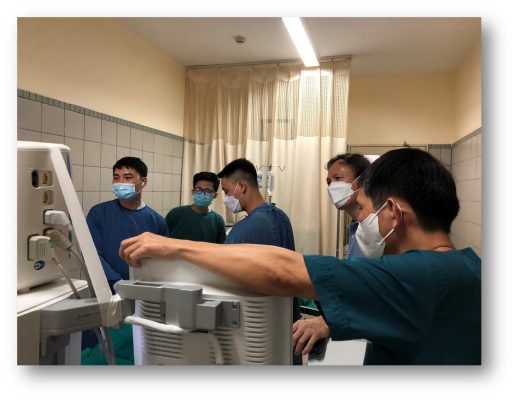Endomucosal Submucosal Dissection (ESD) is an advanced method in the treatment of early gastrointestinal cancers. At Bach Mai Hospital, Hanoi, ESD has been successfully applied, helping many patients have the opportunity for effective treatment without surgery.

ESD implementation team at the Digestive - Hepatobiliary Center, Bach Mai Hospital - VIGES member unit

What is ESD technology?
Endoscopic Submucosal Dissection (ESD) is an advanced endoscopic technique to remove tumors or early cancerous lesions in the digestive tract such as the esophagus, stomach and colon without surgery with many advantages over previous traditional methods. By using special endoscopic instruments, doctors can completely remove tumors located in the mucosal layer without affecting the deeper layers of the digestive tract wall.
Advantages of ESD Technique
- Accurate and safe: ESD allows the surgeon to precisely remove small tumors in the mucosa with minimal damage to surrounding tissues. This helps to minimize the risk of bleeding and post-operative complications.
- Fast recovery time: With ESD technique, patients do not need to undergo traditional open abdominal surgery, so the hospital stay and post-operative recovery time are significantly shortened. Patients can return to normal activities in a short time.
- High treatment efficiency: This method helps to completely eliminate malignant tumors in the early stages, preventing cancer from developing and metastasizing.
ESD Engineering Implementation Process
- Preoperative preparation: The patient will be examined, endoscopy and ultrasound to determine the exact location and size of the tumor.
- Perform submucosal dissection: During endoscopy, the doctor will use specialized instruments to remove the mucosal layer surrounding the tumor. The entire process is monitored through high-resolution endoscopic images.
- Post-operative care and follow-up: After completion, the patient will be monitored at the hospital to ensure safety and limit complications.
Applications of ESD Technology
ESD is widely used in the treatment of tumors, precancers or early cancers of the gastrointestinal tract, including:
- Esophageal cancer
- Stomach cancer
- Colon and rectal cancer
During ESD, the gastroenterologist will:
- An intravenous line is placed to administer anesthesia to make sure you don't feel pain.
- A high-resolution endoscope is passed through your mouth or anus, depending on the location of the tumor.
- Observe the image on the screen to avoid damaging surrounding tissue during the procedure.
- Locate the tumor and mark its boundaries using special instruments through the endoscope.
- Injecting a solution into the layer below the tumor or lesion to separate it from the muscle wall. This helps minimize damage to surrounding tissue during the procedure.
- Using an electrosurgical knife with a high-frequency electric current to “cut” tumor tissue away from the wall of the digestive tract. This current helps coagulate blood vessels to minimize bleeding.
- The tumor is removed from the body through the endoscope and sent to a laboratory for examination by a pathologist.
Recovery after Endoscopic Submucosal Dissection
After ESD, you will be monitored as the anesthesia wears off. Your doctor will discuss the results with you before you go home.
Examination of the tissue under a microscope by a pathologist can confirm whether the procedure completely removed the tumor.
As you recover, you may experience:
- Sore throat if the endoscope is passed through the mouth.
- Nausea or vomiting if your stomach or intestines are treated.
- Bloating, abdominal distension, or cramps, especially if the doctor inflates the abdomen during treatment.
With a team of highly qualified doctors and modern equipment, Bach Mai Hospital is proud to be a pioneer in applying ESD technique and many other modern techniques in the treatment of early gastrointestinal cancer, bringing hope to many patients at home and abroad.
Conclude
ESD technique is a new step forward in medicine, helping to improve the quality of life and the chance of successful treatment for patients with gastrointestinal cancer.
